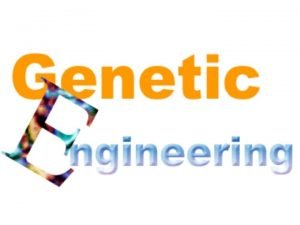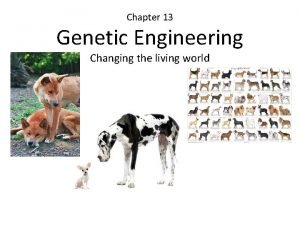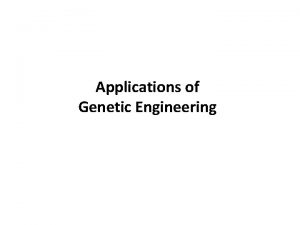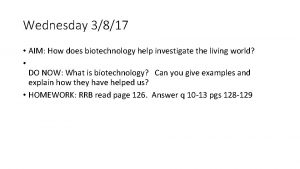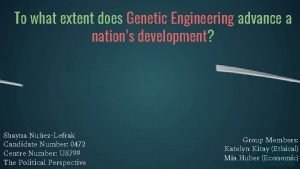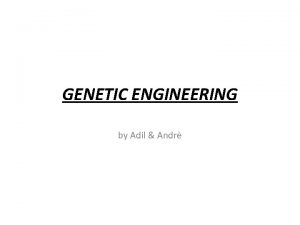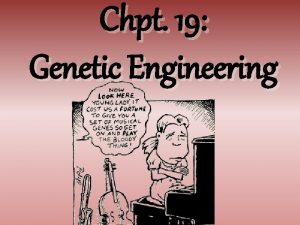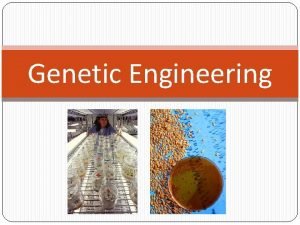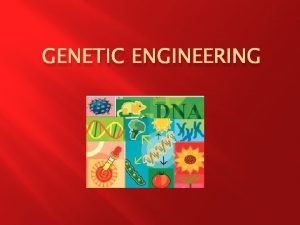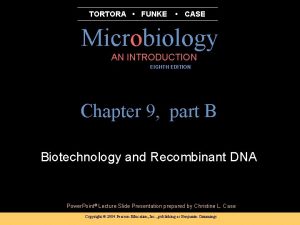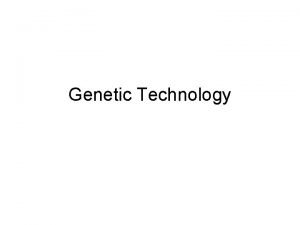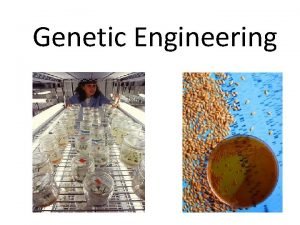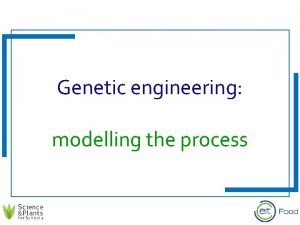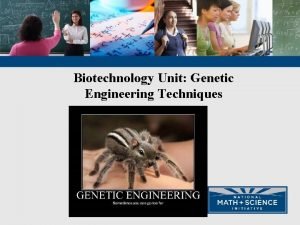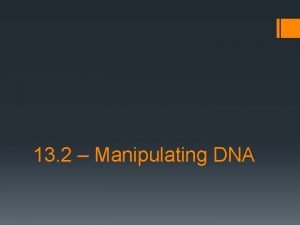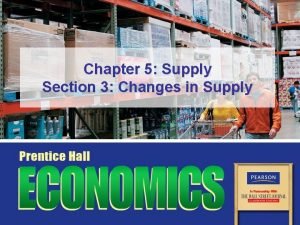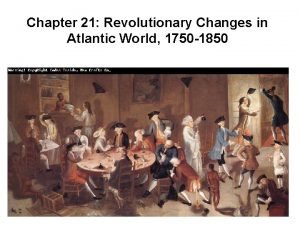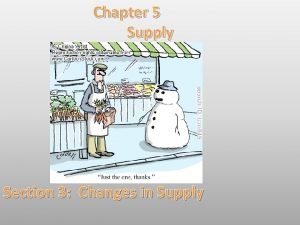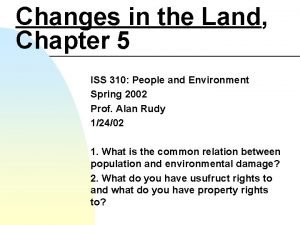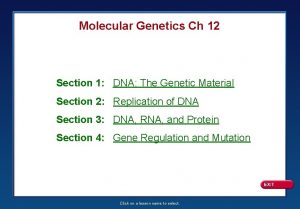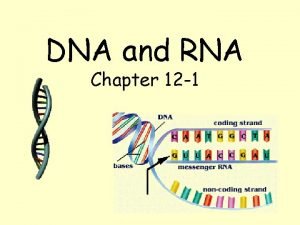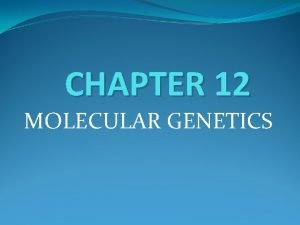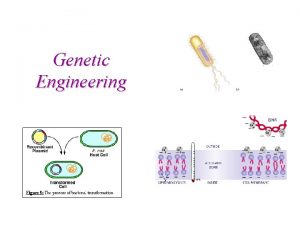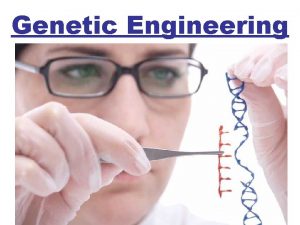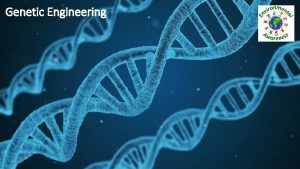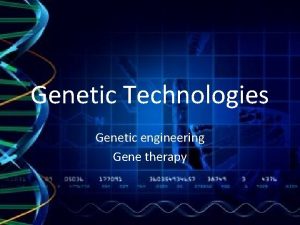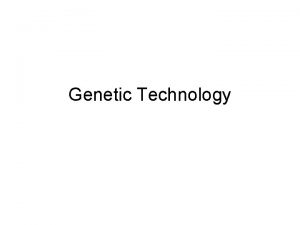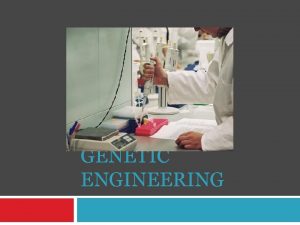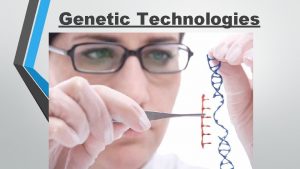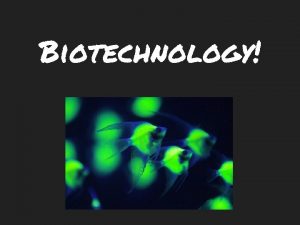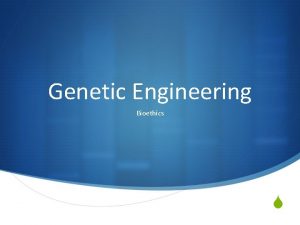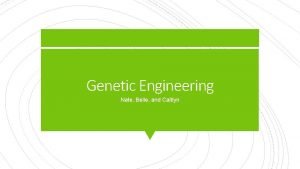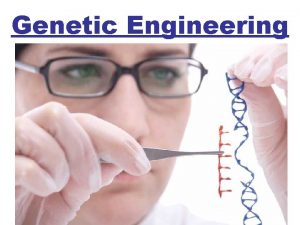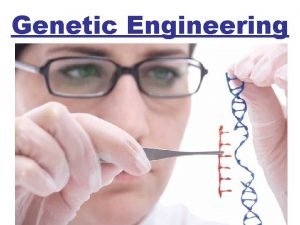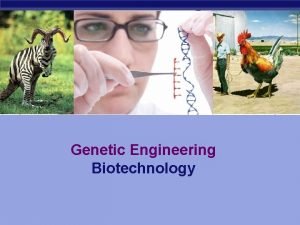Genetic Engineering Chapter 13 Genetic engineering Making changes












































- Slides: 44

Genetic Engineering Chapter 13

Genetic engineering • Making changes to the DNA code of an organism – Selective breeding – Increased variation – Cloning – Genetically modified foods

Changing the Living World • Crop Selection – Grower selects the seeds of the best crops to plant each year – Eventually alleles are uniform in producing desirable traits (REMEMBER: GENETICS!) • Selective breeding: allowing only animals (or plants) with desired characteristics produce the next generation • Domestic animals and crops are made by selective breeding

Species vs. breed Species • A group of organisms that are able to reproduce together and in doing so create viable offspring

Species vs. Breed • animals or plants within a species having a distinctive appearance and typically having been developed by deliberate selection

Selective Breeding • Different breeds are not different species

Types of selective breeding Hybridization • Crossing dissimilar individuals to bring together the best of both organisms – Offspring are “better” then either parent Inbreeding • Continued breeding of individuals with the same characteristics • Used to maintain a desired characteristic • Risk bringing together 2 recessive traits that cause a defect

Hybridization vs. Inbreeding 1. Pick a crop or animal breed 2. Pick 2 desirable characteristics 3. How does hybridization allow for the production of the “best” offspring 4. How does inbreeding allow the “best” traits to stay in the offspring.

Cont. • Challenges with Hybridization: – Takes many years to bring a new variety of crop to market. – Linkage between genes require trade-offs that can compromise the crop • video

Genetic Engineering • Making changes to the DNA code – DNA extraction • How did we do this? ? ? – Cutting DNA • Restriction enzymes- cut the DNA at a specific sequence of nucleotides

Genetic Engineering • Separating DNA – Gel Electrophoresis

Manipulating DNA • How are scientists able to change DNA? • Based on the knowledge of DNA structure, scientists are able to change DNA molecules.

Cutting and Pasting • Short sequences of DNA are added to the original DNA strand

Making Copies • Polymerase chain reaction (PCR) – Primers are added to either end of the DNA strand – DNA polymerase is added and starts making copies of the DNA

Cell transformation • Cell Transformation: genetic alteration of a cell resulting from the uptake of foreign DNA – Outside DNA becomes apart of the cell DNA – Produces recombinant DNA

Steps the Cell Transformation 1. DNA is joined to a small bacterial plasmid (DNA)

Step 1 • Restriction enzymes – Cuts DNA at a specific sequence – Must match the DNA sequence exactly

Why are plasmids used? • Contains a DNA sequence that promotes replication • Contains a genetic marker that makes it easy to find – A gene that is used to find the plasmid in a cell

Cell Transformation 2. DNA is injected into plant or animal cells 3. When plant grows the DNA is incorporated into every cell Animation

Cell transformation Animation

Genetic variation • Genetic variation: different forms of the same gene (alleles) • Why is variation important in organisms? • Why would plant and animal breeders want there to be variation among individuals in a species?

Increasing Variation • What causes variation among species? – Genetic variation can be increased in a population by introducing mutations – Mutations are the source of variation • Mutation rate is increased by using radiation and chemicals – Plant and animal breeders induce mutations by exposing individual organisms to radiation and chemicals

A new way to induce variation • Why would breeder/ scientist look for a new way to induce variation? – Cant control the type of mutation – Many mutations are harmful – Organisms can be killed during exposure to radiation and chemicals • Genetic Engineering allows scientist to choose exactly how they are changing the organism

Steps to Genetically modifying a crop • Genes are transferred through bacterial plasmids 1. 2. 3. 4. 5. 6. Isolation of the gene(s) of interest Insertion of the gene(s) into a transfer vector Plant transformation Selection of the modified plant cells Regeneration into whole plants via tissue culture Verification of transformation and characterization of the inserted DNA fragment 7. Testing of plant performance 8. Safety assessment

Reading the sequence 1. A single stranded DNA is placed in a test tube 2. DNA polymerase and nucleotides are added to the test tube – Some nucleotides have chemical dyes attached to the that serve as genetic markers 3. When a dye labeled base is added synthesis is terminated 4. Segments are put together in order of length Diagram pg. 324


Using the DNA sequence • DNA can be read, studied and even changed How DNA can be used • Study specific genes • Compare genes of one organism to genes of another • Discover the function of different genes and gene combinations

How is DNA read • Gel Electrophoresis- DNA is separated based on charge and size

Forensics

How is DNA read • Genetic Markersnucleotides that have a specific dye attached to them • When the DNA is ran through a gel the nucleotides appear a specific color

Applications of Genetic Engineering

Transgenic Organisms • Transgenic organisms- contain genes from other species – How is this possible?

Transgenic Microorganisms • First transgenic organisms to be produced • Reproduce quickly and easily • Help to treat human disorders at lower cost and safer Examples of use • Protein production (insulin, clotting factor)

Transgenic Animals • Used to study genes and improve food supply Example: 1. Mice that have immune systems similar to humans (used to test disease/drugs) 2. Livestock with extra copies of growth hormone (produce leaner meat and more milk)

Transgenic Plants • Used to improve food supply – Produce natural insecticides – Resist weed killing chemicals Example: Genetically modified food supply – 52% of soy beans – 25% of corn – Rice

GM foods Benefit Risk • Reduced pesticides and herbicide use • Reduced Fertilizer use • Use of land recovery • Development of specialty crops • Allergies • Gene Flow • Damage to animals from pollen • Transfer of Antibiotic resistance • Alteration of soil ecology • Dangers of eating foreign DNA

Cloning • The process of producing populations of genetically identical individuals – The copied material, which has the same genetic makeup as the original, is referred to as a clone.

Gene cloning • gene cloning – Copies of genes • Using recombinant DNA to create multiple copies of the same gene

Reproductive cloning • reproductive cloning – Copies of whole organisms • Cloning is the creation of an organism that is an exact genetic copy of another. – Identical twins are natural clones • Somatic cell nuclear transfer – researchers isolated a somatic cell from an adult female. Next, they transferred the nucleus from that cell to an egg cell from which the nucleus had been removed.

Cloning

Therapeutic Cloning • therapeutic cloning – Produces embryonic stem cells for research • Stem cells are used to study human development and diseases – Stem cellsundifferentiated cells

Human Cloning • Would a human clone be identical to the person it was cloned from? – Genetically? – Personality? – Opinions?

Ethics of Cloning • How could cloning be used to help us? • Why would some people not want cloning to be allowed? • Are there any cases where cloning would be accepted?

Genetically Modified foods • What is the science involved in genetic engineering crops? • How is genetic engineering different from more traditional genetic manipulations, such as hybridization? • What steps are usually involved in genetically modifying foods? • What are the known or projected risks and benefits of genetically modifying crops?
 Elizabeth mulroney
Elizabeth mulroney Neena haridas
Neena haridas Founder effect
Founder effect Genetic programming vs genetic algorithm
Genetic programming vs genetic algorithm Genetic programming vs genetic algorithm
Genetic programming vs genetic algorithm Genetic drift vs genetic flow
Genetic drift vs genetic flow What is the difference between genetic drift and gene flow
What is the difference between genetic drift and gene flow What is inference
What is inference War making and state making as organized crime summary
War making and state making as organized crime summary Production of insulin
Production of insulin Section 13-1 changing the living world
Section 13-1 changing the living world Genetic engineering
Genetic engineering Cloning tasmanian tiger
Cloning tasmanian tiger Purpose of genetic engineering
Purpose of genetic engineering Genetic engineering conclusion
Genetic engineering conclusion Oryx and crake genetic engineering
Oryx and crake genetic engineering Pros and cons of genetic engineering
Pros and cons of genetic engineering Steps in genetic engineering
Steps in genetic engineering Bioluminescence genetic engineering
Bioluminescence genetic engineering Objectives of genetic engineering for class 10
Objectives of genetic engineering for class 10 Agrobacterium tumefaciens genetic engineering
Agrobacterium tumefaciens genetic engineering Genetic engineering
Genetic engineering Algenol
Algenol Genetic engineering
Genetic engineering Genetic engineering
Genetic engineering Section 13-2 manipulating dna answer key
Section 13-2 manipulating dna answer key Equation analysis sheet
Equation analysis sheet Chapter 10 geriatric care
Chapter 10 geriatric care Chapter 22 accounting changes and error analysis solutions
Chapter 22 accounting changes and error analysis solutions Chapter 5 section 3 changes in supply
Chapter 5 section 3 changes in supply Chapter 3 analyzing changes in financial position answers
Chapter 3 analyzing changes in financial position answers Chapter 21 revolutionary changes in the atlantic world
Chapter 21 revolutionary changes in the atlantic world Chapter 5 section 3 changes in supply
Chapter 5 section 3 changes in supply Chapter 3 analyzing changes in financial position answers
Chapter 3 analyzing changes in financial position answers Counterbalancing example
Counterbalancing example Changes in the land chapter 5 summary
Changes in the land chapter 5 summary Chapter 6 section 2 changes in market equilibrium
Chapter 6 section 2 changes in market equilibrium Chapter 12 section 1 dna the genetic material
Chapter 12 section 1 dna the genetic material Chorionic villus
Chorionic villus Chapter 12 section 1 dna the genetic material
Chapter 12 section 1 dna the genetic material Chapter 12 molecular genetics
Chapter 12 molecular genetics Molecular genetics chapter 12
Molecular genetics chapter 12 On and off
On and off Section 12-1 dna
Section 12-1 dna Chapter 6 prices and decision making assessment answers
Chapter 6 prices and decision making assessment answers









